Manners, Customs, Clothing
 |
 |
 |
 |
 |
 |
 |
Striving for Order & Decorum at Mealtimes
This question was sent by a reader:
Dear TIA,
What is the best way to serve meals in the context of the family?
When I was a child one of my duties was to lay the table. My mother placed the food in the middle of the table and dished it out while seated (there were only four of us).
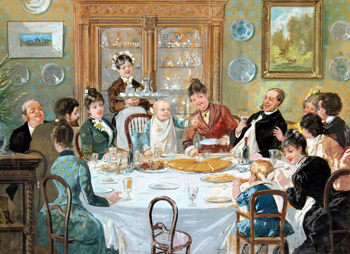 This arrangement isn’t working for my family. Even though I enjoy cooking, I find serving difficult and mealtime stressful. We have ten children and no space for a big enough table. If I put the food on the table, I find that I can’t reach the different dishes from behind the children as the chairs are in the way. If I serve buffet style, I find that someone is always getting up for seconds or to get a forgotten knife or fork. Passing around the dishes isn’t working.
This arrangement isn’t working for my family. Even though I enjoy cooking, I find serving difficult and mealtime stressful. We have ten children and no space for a big enough table. If I put the food on the table, I find that I can’t reach the different dishes from behind the children as the chairs are in the way. If I serve buffet style, I find that someone is always getting up for seconds or to get a forgotten knife or fork. Passing around the dishes isn’t working.
I guess, a lot of the friction has to do with young children still being in training with manners, etc. I have set up a buddy system where an older child is serving a younger child, and this is taking the burden off of having to fill 12 plates; but it still feels frenetic.
So my question is, for a large family what is the best serving practice at mealtimes (buffet, passing around or serving from behind)?
Kindest regards,
L.O.
Miss Elizabeth Lozowski responds:
Dear L.O.,
We congratulate your desire to bring manners and protocol to your family table. It is said that the most important formation that a child will receive is given around the family table. To form a child well it is necessary to have order, calm and a genial ambience that encourages good conversation. Above all, there must be a sense of hierarchy at the table, with the adults leading the conversation and the children prepared to serve as soon as they are able.
English or Russian service
Serving customs at family meals have always varied based on a family’s preference, customs and social class. All three of the serving practices mentioned – buffet, passing, and serving – are acceptable. The two general types of service are English (also called French) service and Russian service.
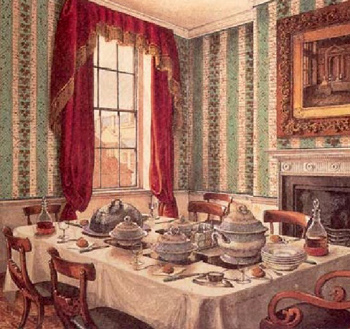 English service is most commonly used in families and consists in food being served at the table by the host or hostess. The serving dishes are placed before the host or hostess (in this case mother and father) and both may help to distribute the food on each person’s plate before being passed to the guest. Typically, roasts and other meat courses are placed before the host who has the honor to cut slices for his guests.
English service is most commonly used in families and consists in food being served at the table by the host or hostess. The serving dishes are placed before the host or hostess (in this case mother and father) and both may help to distribute the food on each person’s plate before being passed to the guest. Typically, roasts and other meat courses are placed before the host who has the honor to cut slices for his guests.
Russian service (à la Russe) is the more formal type of table service that requires servants, unless your older children are able to perform the services. The food is either arranged on plates in the kitchen or carried in platters or bowls into the dining room; these plates are offered to each person to serve himself. A side table may be set up in the dining room where all the dishes are placed and from which the servants take the dishes to serve the guests.
Either of the two services can be adapted to suit your needs. For instance, if you choose to try English service, part of the burden may be taken off of you by having the dishes placed next to both you and your husband. Then, your husband may assist you in plating the food, and the plates can simply be passed to each child. When a child would like seconds, simply have him pass the plate to you or your husband. Or pass the dish of food to that child.
To establish hierarchy in the home, it would be best if you could serve the eldest child first, continuing on to the youngest; however, if the seating arrangement does not lend itself well to this, you may simply pass plates to the child at the end of the table.
If you choose to try Russian service, you may designate two or three of your children to act as the servants – or the medieval ‘pages’ for the boys – carrying the dishes to each member of the family. The parents should be served first, starting with the mother, then the father, and then around to the other children.
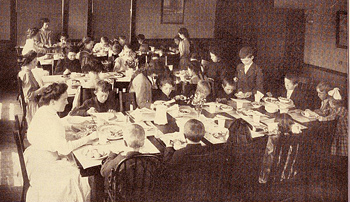 You could also plate all of the food in the kitchen, a task your children may assist you with before the meal, then have the designated servers carry the plates to the table. Another option is to place the filled plates on the table before the family members take their seats.
You could also plate all of the food in the kitchen, a task your children may assist you with before the meal, then have the designated servers carry the plates to the table. Another option is to place the filled plates on the table before the family members take their seats.
An adaptation of the Russian service could be for family members to serve themselves buffet style from the side table.
Because it has become rare for families to have servants in these days, such adjustments will present themselves, such as the one you suggested: assigning an older child "guide" for each of the younger children.
The sitting arrangement
Having an established seating arrangement may help to create a more ordered mealtime ambience, if such an setup is not already implemented in your home. The father and mother should be at the proper seats at both ends of the table (the most common custom). According to the rules of etiquette, the guest of honor (typically a lady) always sits to the right of the host, and the second guest of honor (typically a man) sits to the right of the hostess.
In a family, the same protocol can be followed with the eldest daughter seated to the right of the father and the eldest son to the right of the mother. Or simply the two eldest children may be seated in those places. Again, adaptations can be made to serve your family's needs and preferences.
Engage the children's help
Your endeavor to give the older children the responsibility of caring for the younger is an important step in teaching your children the sense of duty. All should be helping to make mealtimes as pleasant and decorous as possible.
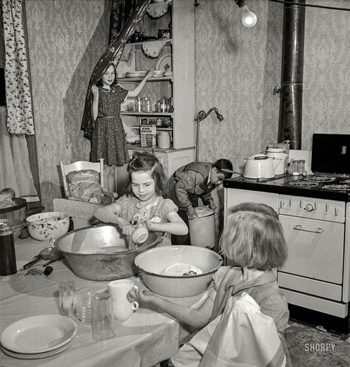 The more you can teach your children to serve each other at the table, the better will their manners become. All children should be courteous and attend to the needs of others at the table. If a child would like more to eat, he or she should politely and quietly ask for more, not forgetting to say please and thank you.
The more you can teach your children to serve each other at the table, the better will their manners become. All children should be courteous and attend to the needs of others at the table. If a child would like more to eat, he or she should politely and quietly ask for more, not forgetting to say please and thank you.
Boys should especially be taught to consider their sister’s wants before their own, with the aim of becoming chivalrous gentlemen who always offer assistance to ladies. Many families used to arrange the seating so that a son could be to the left of a daughter in order to pull out her chair to seat her properly.
We also recommend giving your children tasks to complete that will help with preparations for the meal. Some can decorate the table, perhaps by picking flowers to place in small vases. Others can set the table with the proper settings. Others can fill water glasses. Others can help you in the kitchen, and so on until the meal is ready.
Now, as you mentioned, young children often have a difficult time sitting still at table. For this reason, some traditional families have found it more beneficial to feed the young ones separately before the general meal time for the rest of the family.
When a young child shows himself to be well-behaved at the children’s table, he is then able to join the older children and his parents. This gives children an incentive to learn table manners. You may find this works well for you if you choose an older child to help feed the younger ones and instruct them in manners during their meal time. They can then be sent to play or to bed while the rest of the family dines.
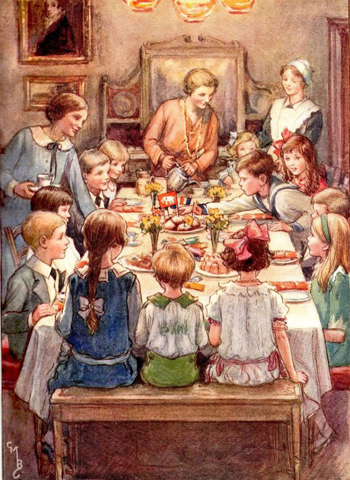 Another custom in some families is to have a separate children's table apart from the main dining table. The younger children, assisted by an older child assigned to the table, take their meal there. Thus, they remain in the same room with the family, but do not have liberty to become the center of attention, or distract the others with antics or bad behavior.
Another custom in some families is to have a separate children's table apart from the main dining table. The younger children, assisted by an older child assigned to the table, take their meal there. Thus, they remain in the same room with the family, but do not have liberty to become the center of attention, or distract the others with antics or bad behavior.
A word from the father or the mother at the main table restores the discipline at the children's table should things become a bit rowdy. This custom also encourages the younger children to behave well to join the adults and older children at the main table.
These are some practical suggestions we offer, hoping that they will be of some help to you. The more you can maintain a serene atmosphere at the table, the more pleasant meal time will be for all. The more you can delegate responsibilities to your children regarding the work and chores involved with setting the table, preparing the food and clearing the table, the more pleasant and calm meal time will become for you, the mother.
Do not fear to demand "too much" from your children. Today, sadly, most parents call for much too little.
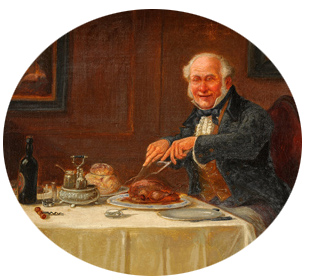

Dear TIA,
What is the best way to serve meals in the context of the family?
When I was a child one of my duties was to lay the table. My mother placed the food in the middle of the table and dished it out while seated (there were only four of us).

Striving for a unstressful family dinner -
without the maid...
I guess, a lot of the friction has to do with young children still being in training with manners, etc. I have set up a buddy system where an older child is serving a younger child, and this is taking the burden off of having to fill 12 plates; but it still feels frenetic.
So my question is, for a large family what is the best serving practice at mealtimes (buffet, passing around or serving from behind)?
Kindest regards,
L.O.
Miss Elizabeth Lozowski responds:
Dear L.O.,
We congratulate your desire to bring manners and protocol to your family table. It is said that the most important formation that a child will receive is given around the family table. To form a child well it is necessary to have order, calm and a genial ambience that encourages good conversation. Above all, there must be a sense of hierarchy at the table, with the adults leading the conversation and the children prepared to serve as soon as they are able.
English or Russian service
Serving customs at family meals have always varied based on a family’s preference, customs and social class. All three of the serving practices mentioned – buffet, passing, and serving – are acceptable. The two general types of service are English (also called French) service and Russian service.

An English service table setting,
below, a Russian style table setting

Russian service (à la Russe) is the more formal type of table service that requires servants, unless your older children are able to perform the services. The food is either arranged on plates in the kitchen or carried in platters or bowls into the dining room; these plates are offered to each person to serve himself. A side table may be set up in the dining room where all the dishes are placed and from which the servants take the dishes to serve the guests.
Either of the two services can be adapted to suit your needs. For instance, if you choose to try English service, part of the burden may be taken off of you by having the dishes placed next to both you and your husband. Then, your husband may assist you in plating the food, and the plates can simply be passed to each child. When a child would like seconds, simply have him pass the plate to you or your husband. Or pass the dish of food to that child.
To establish hierarchy in the home, it would be best if you could serve the eldest child first, continuing on to the youngest; however, if the seating arrangement does not lend itself well to this, you may simply pass plates to the child at the end of the table.
If you choose to try Russian service, you may designate two or three of your children to act as the servants – or the medieval ‘pages’ for the boys – carrying the dishes to each member of the family. The parents should be served first, starting with the mother, then the father, and then around to the other children.

A boardinghouse table gives an example of order maintained
An adaptation of the Russian service could be for family members to serve themselves buffet style from the side table.
Because it has become rare for families to have servants in these days, such adjustments will present themselves, such as the one you suggested: assigning an older child "guide" for each of the younger children.
The sitting arrangement
Having an established seating arrangement may help to create a more ordered mealtime ambience, if such an setup is not already implemented in your home. The father and mother should be at the proper seats at both ends of the table (the most common custom). According to the rules of etiquette, the guest of honor (typically a lady) always sits to the right of the host, and the second guest of honor (typically a man) sits to the right of the hostess.
In a family, the same protocol can be followed with the eldest daughter seated to the right of the father and the eldest son to the right of the mother. Or simply the two eldest children may be seated in those places. Again, adaptations can be made to serve your family's needs and preferences.
Engage the children's help
Your endeavor to give the older children the responsibility of caring for the younger is an important step in teaching your children the sense of duty. All should be helping to make mealtimes as pleasant and decorous as possible.

Children can be engaged at young ages in the meal preparation & clean-up
Boys should especially be taught to consider their sister’s wants before their own, with the aim of becoming chivalrous gentlemen who always offer assistance to ladies. Many families used to arrange the seating so that a son could be to the left of a daughter in order to pull out her chair to seat her properly.
We also recommend giving your children tasks to complete that will help with preparations for the meal. Some can decorate the table, perhaps by picking flowers to place in small vases. Others can set the table with the proper settings. Others can fill water glasses. Others can help you in the kitchen, and so on until the meal is ready.
Now, as you mentioned, young children often have a difficult time sitting still at table. For this reason, some traditional families have found it more beneficial to feed the young ones separately before the general meal time for the rest of the family.
When a young child shows himself to be well-behaved at the children’s table, he is then able to join the older children and his parents. This gives children an incentive to learn table manners. You may find this works well for you if you choose an older child to help feed the younger ones and instruct them in manners during their meal time. They can then be sent to play or to bed while the rest of the family dines.

A children's table, where the young ones learn good manners & eat apart from the adults
A word from the father or the mother at the main table restores the discipline at the children's table should things become a bit rowdy. This custom also encourages the younger children to behave well to join the adults and older children at the main table.
These are some practical suggestions we offer, hoping that they will be of some help to you. The more you can maintain a serene atmosphere at the table, the more pleasant meal time will be for all. The more you can delegate responsibilities to your children regarding the work and chores involved with setting the table, preparing the food and clearing the table, the more pleasant and calm meal time will become for you, the mother.
Do not fear to demand "too much" from your children. Today, sadly, most parents call for much too little.

A father carving the meat at the table

Posted September 26, 2022
______________________
______________________








